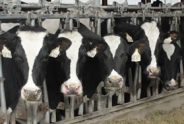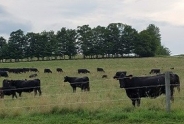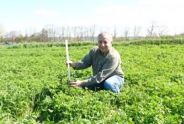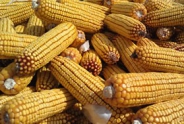Field Crop Update May 7, 2025
Erik Smith, Area Field Crop Specialist/Team Leader
Central New York Dairy and Field Crops
1. Field Observations
Not much activity in the fields these days, though I have seen a few folks spreading and tilling where possible, in-between downpours. Rain is forecast to continue through this week as I'm sure everyone is well aware, so pay close attention to your winter forage crops and their development. Harvest your best fields first to capture peak quality, and don't try and chase quality in fields that are already past. Some of us may be ready to harvest alfalfa/grass mixed stands as soon as the ground is dry enough!! And some winter forages may unfortunately be heifer feed.
But while winter forages like triticale might be moving quickly, the same may not be true for the grasses in your alfalfa fields. Here is a recent note from Joe Lawrence, Dairy Forage System Mgmt Specialist with Cornell PRO-DAIRY:
"Based on my observations and the reports of alfalfa heights coming in, alfalfa is progressing quickly and grass progress seems to be a bit slower. As happens every few years, this sets up a scenario where alfalfa heights suggest it is time to cut grass; however, grass will still be pretty immature with seedheads still very low in the stem. To avoid negative consequences to 2nd cutting (rapid head emergence, stunted regrowth) the grass seed head needs to be cut off with mowing of first cutting. i.e. 4" above soil surface if following the recommended 4" cutting height is being followed. See some information and a picture [below]. Also [pictured below] is just a quick summary of data many of the CCE teams have been sharing with me the last few years…."
Assuring the seed head is above cutting height (4"):
In springs where alfalfa development seems to outpace grass development, alfalfa height measurements can indicate it is time to cut grass (see graph) before the grass seedhead has progressed up to the stem to a point where it will be removed during mowing (4" above soil surface). If the seedhead is not removed with cutting it will have negative consequences of grass regrowth. The intact seedhead will emerge shortly after mowing and stunt regrowth. When this occurs, it is better to wait for the seedhead to elongate above the cutting height even if this is slightly past the harvest timing suggested by the alfalfa height. Grass progress can be rapid at this time so the delay needed will not be long and it is important to track progress frequently during this time.
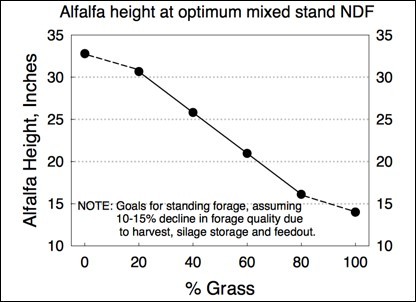

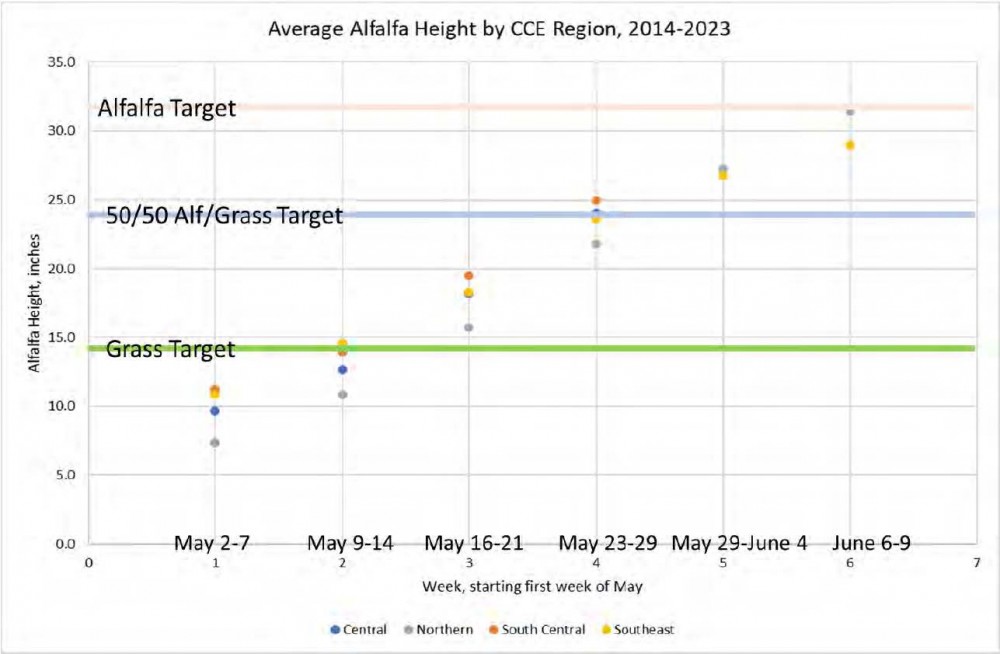
2. First Cutting Forage Quality
Alfalfa height is a reliable indicator of NDF values in the field, so we use alfalfa height to predict Neutral Detergent Fiber (NDF) for alfalfa, mixed alfalfa/grass, and pure grass stands. When using alfalfa and grass height as an indicator of NDF content, in general:
Begin cutting 100% grass stands when nearby alfalfa is 14" tall to achieve the desired 50% NDF.
Begin cutting 50/50 alfalfa/grass stands when nearby alfalfa is 22" tall for the desired 44% NDF.
Begin cutting 100% alfalfa stands when alfalfa is 28" tall for the desired 40% NDF.
To achieve the desired NDF it is necessary to begin cutting at NDF values slightly lower than the desired value assuming some harvest and storage losses (which the above alfalfa height values reflect). For example 28 inch tall alfalfa is closer to 38% NDF but you will need to start then to end up at 40% NDF.
Predicted days to cut are based on daily NDF increases for grasses (1%), 50/50 mixed stands of (0.8%), and alfalfa (0.5%). Typically, NDF increases about 0.8 to 1.2/day for grasses and 0.4 to 0.7/day in alfalfa, expecting the lower end of that range in cooler weather and the higher end in warm. See the following fact sheet for more details: Predicting Spring Fiber Content of Forages.
Always check your fields to verify your heights and conditions! Remember that these predicted harvest dates are not set in stone, and will fluctuate as we go along. And they may creep up on us - especially since the fields are getting a lot of moisture now, and the temperature is only going up!
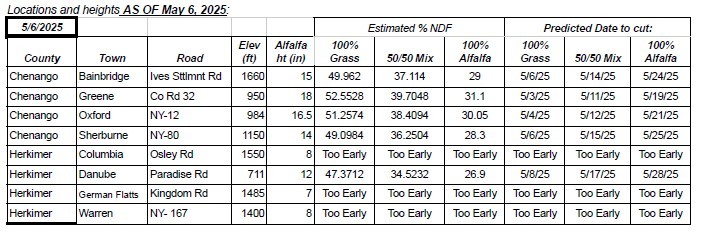
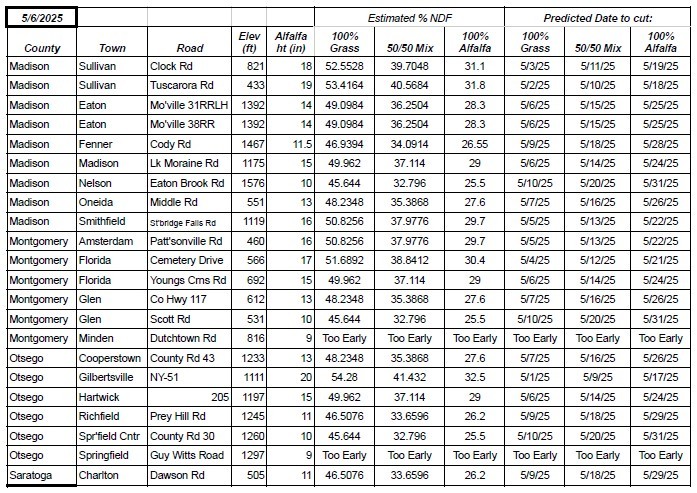

If your location is not listed but you know the height of your alfalfa, this chart is for you. As of May 6, 2025:
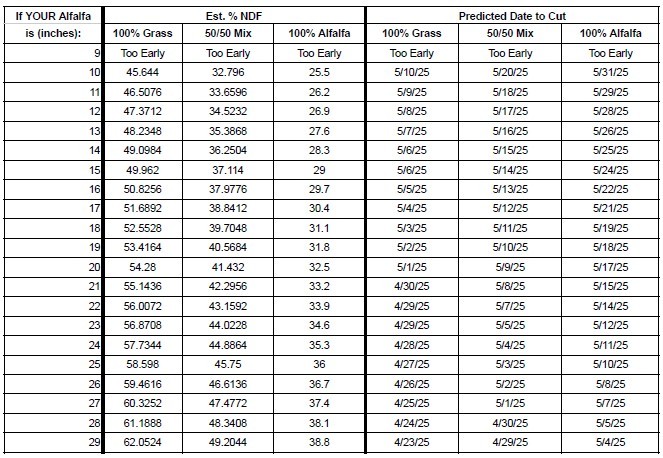
3. Growing Degree Days (GDD) (See: Climate Smart Farming Growing Degree Day Calculator)
Growing degree days (GDD) are calculated by taking the average daily temperature and subtracting the base temperature for development of a given organism ((High + Low)/2 - base temp = GDD). For corn silage, we are using base 50/86, as corn development starts at 50 degrees F and ceases above 86. Check your location and planting date (more planting dates to come):
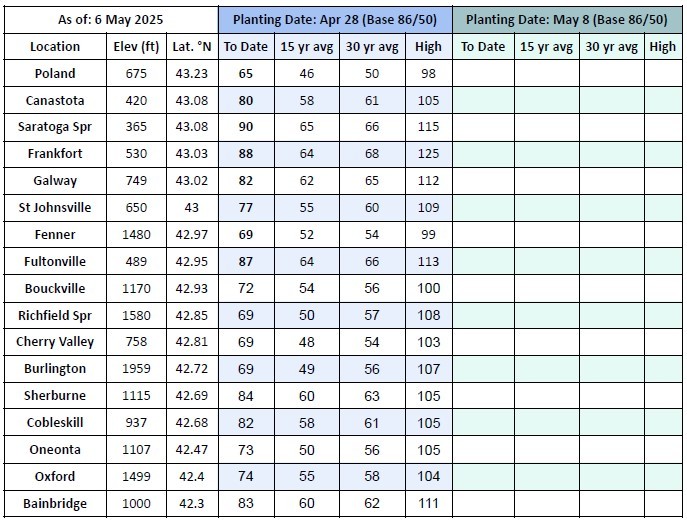
4. Pest Monitoring
This year we will again monitor for several field crop pests, including black cutworm, western bean cutworm, true armyworm, fall armyworm, and potato leafhopper. In the coming weeks, I'll deploy my traps at the locations below. We will have more of this information as the weeks progress.
BCW = Black Cutworm
TAW = True Armyworm
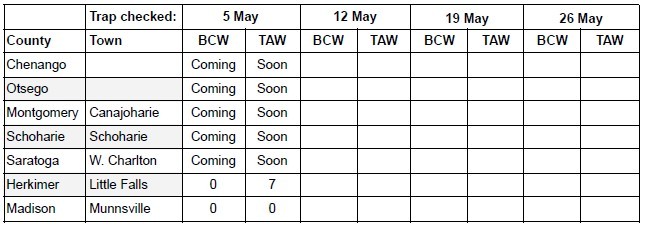
See you in the field!
Upcoming Events
Labor Roadshow IX
December 1, 2025
December 9 - December 10, 2025December 17 - December 18, 2025December 22, 2025
In-person and online events to keep NY's agricultural employers informed and prepared for today's labor challenges.
2026 Dairy Day
January 13, 2026 : Dairy Day - Hamilton
Hamilton, NY
Lunch included
January 14, 2026 : Dairy Day - Ballston Spa
Ballston Spa, NY
Lunch included
2026 Corn & Soybean Day
January 20, 2026 : Corn & Soybean Day - Hamilton
Hamilton, NY
Lunch included. 2.75 DEC Credits available
January 21, 2026 : Corn & Soybean Day - Ballston Spa
Ballston Spa, NY
Lunch included. 2.75 DEC Credits available
Announcements
Statewide Field Crop Pathology Needs Assessment Survey
Your input is wanted for identifying priorities!Sign Up for Our Weekly E-Newsletter
We send out a bi-weekly e-newsletter that has announcements, upcoming programs, and opportunities for you! Registration is quick, easy, and free. Click here to sign up today!Farmers Can Join MeatSuite For Free!
MeatSuite.com is a free resource provided by Cornell University where NY meat farmers can create a farm profile and list their bulk (wholes, halves, quarters) and bundled (i.e. Grilling Bundle) meat products.Why should farmers join?
1. It's free and easy!
2. Connect with more local customers. In the past year the MeatSuite.com farm directory had 8,300 visits from New York consumers. Farm profiles get as many as 25 views per month from potential local customers. We also spotlight MeatSuite farms on social media and bring attention and purchases to farms through highlights and giveaways.
How do I join?
Farmers can visit https://www.meatsuite.com/farmers/ to create a free farm profile. You must list at least one product for your farm's profile to go live. You'll also have access to Cornell's free Meat Price Calculator, a helpful tool for pricing your meat to make a profit.
While you're on MeatSuite, check out the "Creating Consumer-Friendly Bulk Meats" publication on the log-in page. It has tips on how to create bulk meat products that are easier for first-time buyers to say "yes" to.
If you have any questions as you create your farm profile or products, we're here to help! Please email Matt LeRoux at mnl28@cornell.edu.

